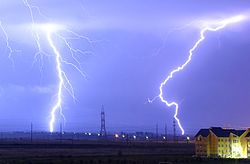Energy
Energy can mean various things:
- In physics, energy is a property of matter and space. It can be transferred between objects. It can be converted in its form. It cannot be created or destroyed.
- In economics it may mean the ‘energy industry’, as in fuel or electric power distribution.
- Energy can be used to heat, move or illuminate.
- In everyday use, the word is used to describe someone acting or speaking in a lively and vigorous way.
Scientific energy
In physics, energy is a property intrinsic to anything that is able to interact in the universe. The energy of an object is its capability of producing a force that can do work, as well as its capability of transferring heat. When an object does work on another object (changing its momentum), the former’s energy (its capability of doing work) decreases and the latter’s energy increases, by transferring it.
Basic forms of energy include:
- Kinetic energy - energy of an object in motion, which acts as the capacity to undergo change in position over time.
- Potential energy - the potential a stationary object has to cause a force because it has mass, its position relative to other objects, or stresses within itself (elasticity). Motion is also relative.
- Heat - thermal energy which is used to vibrate atoms and molecules.
- Electrical energy - energy that relates to electrical interactions.
Conservation of energy
Energy is a property that is not created or destroyed, although energy can change in detectable form.[1] This is a rule that is commonly understood as the "conservation law of energy". In respects to this rule, the total amount of energy that exists in an isolated system will always be the same, no matter what changes have been made to it.
In the early 20th century, scientist found that matter itself can be created from energy (energy and matter are interchangeable, in spite of everyday experiences). This is just another change of form. After these discoveries, the conservation law of energy was extended to become the conservation law of matter and energy: matter and energy can neither be created from nothing nor destroyed to the point of complete erasure from reality. Albert Einstein was the first to mathematically show this. (E = mc2)
Matter can be created from energy or converted into energy through processes such as nuclear fission or nuclear fusion.
Types of energy
Scientists have identified many types of energy, and found that they can be changed from one kind into another. These include:
- Chemical energy
- Sound energy
- Renewable energy
- Solar energy
- Nuclear energy
- Elastic energy
- Gravitational potential energy
- Kinetic energy
- Dark energy
- Hamiltonian mechanics
- Internal energy
For example:
- Human throws the stone using energy stored in muscles = chemical energy
- Stone moves upwards = kinetic energy
- Stone at the highest point = potential energy
- Stone falls to ground = kinetic energy
- Stone hits ground = thermal energy/sonic energy
Measuring energy
Energy can be measured. The amount of energy a thing has can be given a number.
As in other kinds of measurements, there are measurement units. The units of measurement for measuring energy are used to make the numbers meaningful.
The SI unit for both energy and work is the joule (J). It is named after James Prescott Joule. 1 joule is equal to 1 newton-metre. In terms of SI base units, 1 J is equal to 1 kg m2 s−2. It is most often used in science, though particle physics often uses the electronvolt.
The measurement for electricity most often uses the kilowatt-hour (kW·h). One kW·h is equivalent to 3,600,000 J (3600 kJ or 3.6 MJ).
Energy Media
In a typical lightning strike, 500 megajoules of electric potential energy is converted into the same amount of energy in other forms, mostly light energy, sound energy, and thermal energy.
Thermal energy is energy of microscopic constituents of matter, which may include both kinetic and potential energy.
Thomas Young, the first person to use the term "energy" in the modern sense
Basic overview of energy and human life
A turbo generator transforms the energy of pressurized steam into electrical energy.
Related pages
References
| Wikimedia Commons has media related to Lua error in Module:Commons_link at line 62: attempt to index field 'wikibase' (a nil value).. |
- ↑ Woolley, Steve (2011). Edexcel IGCSE Physics Revision Guide. Pearson Education. p. 49. ISBN 9780435046736.





